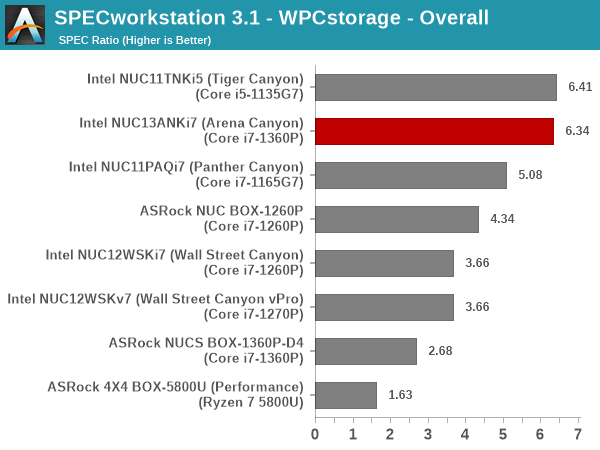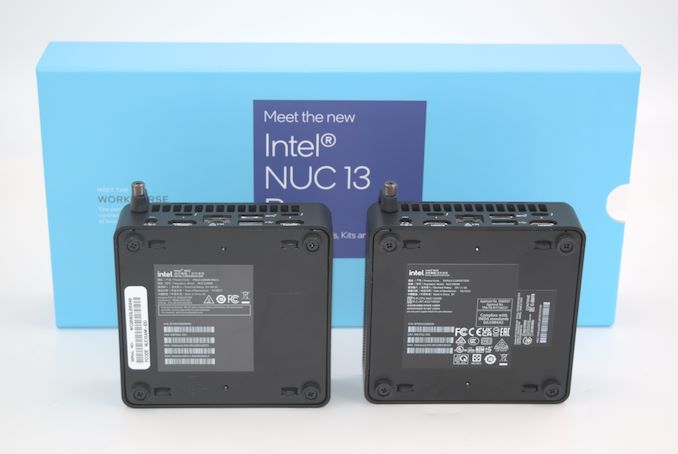Intel NUC 13 Pro Arena Canyon Review: Raptor Lake Brings Incremental Gains
by Ganesh T S on March 27, 2023 9:00 AM ESTMiscellaneous Aspects and Concluding Remarks
Networking and storage are aspects that may be of vital importance in specific PC use-cases. The Intel NUC13ANKi7 (Arena Canyon) comes with the Wi-Fi 6E AX211 WLAN card that also includes Bluetooth 5.3 support. On the wired front, the Intel I226-V controller backs up the 2.5 Gbps RJ-45 port. Dual LAN options are available in select Arena Canyon NUCs, but not in the specific SKU that we looked at today.
On the storage side, we have seen that UCFF PCs typically struggle with PCIe 4.0 x4 NVMe SSDs due to the lack of an effective thermal solution. We saw in the previous section that the temperature profile of the Samsung PM9A1 SSD is quite reasonable under stress. From a benchmarking perspective, we expect the SSD to deliver good scores without throttling in the WPCstorage test of SPECworkstation 3.1. This benchmark replays access traces from various programs used in different verticals and compares the score against the one obtained with a 2017 SanDisk 512GB SATA SSD in the SPECworkstation 3.1 reference system.
| SPECworkstation 3.1.0 - WPCstorage SPEC Ratio Scores | |||

The graphs above present results for different verticals, as grouped by SPECworkstation 3.1. The storage workload consists of 60 subtests. Access traces from CFD solvers and programs such as Catia, Creo, and Solidworks come under 'Product Development'. Storage access traces from the NAMD and LAMMPS molecular dynamics simulator are under the 'Life Sciences' category. 'General Operations' includes access traces from 7-Zip and Mozilla programs. The 'Energy' category replays traces from the energy-02 SPECviewperf workload. The 'Media and Entertainment' vertical includes Handbrake, Maya, and 3dsmax. Given that the comparison is between a wide range of SSDs in the systems - including both Gen 3 and Gen 4 NVMe, the relative numbers for most workloads are not surprising. As expected, the top two spots are taken up by the Gen 4 x4 high-end Samsung PM9A1 in the Arena Canyon NUC and its direct-to-consumer equivalent (980 PRO) in the Tiger Canyon NUC. Both deliver similar numbers within permissible run-to-run variations.
Closing Thoughts
The NUC 13 Pro Arena Canyon lineup is one of Intel's most comprehensive offerings in the UCFF space for business use-cases. A decade of experience listening to customers and analyzing deployments has allowed the company to produce a system with just the right mix of hardware and software features for different domains. The NPSS software feature for digital signage applications addresses some of the pain points inherent in existing solutions. Addition of a powerful processor in the background enables these displays to bring intelligence into the mix and scale well beyond being dumb terminals.
Despite not being the first to market with a Raptor Lake-P UCFF PC, Intel has managed to make the Arena Canyon NUC stand out. The system BIOS has been optimized to increase power efficiency without sacrificing performance. The sheer number of SKUs ensure that there is a system fulfilling the targeted use-cases for every desired price point.
Intel's Raptor Lake-P is quite close to Alder Lake-P architecturally. The core counts, cache sizes, and heterogeneous combinations are pretty much equivalent. Under such circumstances, it is indeed surprising that just process advancements have enabled Raptor Lake-P to provide satisfactory improvements in performance as well as power efficiency over Alder Lake-P.

NUC 13 Pro Arena Canyon NUC (L), NUC 12 Pro Wall Street Canyon NUC (R) - Hard to Differentiate
Positives aside, it is puzzling to see Intel not taking the lead in bringing DDR5 SODIMM support into the UCFF space. The similarity of the I/Os and board features to the Wall Street Canyon NUCs is also a bit of a concern. While we do not have concrete pricing information yet, online retailer listings seem to place it in the same ballpark as that of the Wall Street Canyon NUCs. Under such conditions, it is difficult to see why anyone would prefer the NUC 12 Pro units over the NUC 13 Pro - particularly when the former is slated to be in the market for the foreseeable future. Intel could have put in some more differentiation between the two - say, allowing in-band ECC to be enabled, or more Thunderbolt 4 ports, or adding a SD card slot, or even just changing the retimers to enable USB 3.2 Gen 2x2 20 Gbps support. Those could have justified a premium and allowed the Wall Street Canyon NUCs and Arena Canyon NUCs to coexist in the market.
The wide range of SKUs, longer life-cycles, and better performance as well as energy efficiency over the previous generation are bright spots for the Arena Canyon NUC lineup. The NUC 13 Pro family comfortably delivers upon its promise, but there exists a nagging suspicion that Intel has deliberately set the bar low this time around.










46 Comments
View All Comments
MrCommunistGen - Tuesday, March 28, 2023 - link
If you're just looking to dabble, you might check out Apple's Refurbished shop. I swear by their shop and use it to help my parents getting inexpensive iDevices as they don't need the latest and greatest.They tend to sell pretty lightly used machines that are only a generation or two old at decently discounted prices. If you buy a laptop or other mobile device, I believe that all 1st party Apple Refurbished devices get a brand new battery as part of the refurb process.
FWIW, it looks like through the refurb site you can get an M1 Mac Mini with 16GB RAM and 512GB SSD for $809. Yes, you lose out on the improvements that the M2 brings, but it saves you almost $200 too.
The M1 is going to be plenty potent compared to your... Core2 Duo(?) based Macbook?
Glaurung - Tuesday, March 28, 2023 - link
If you can't stomach apple's prices, check out refurbished/lightly used apple gear on backmarket or, for older machines you can upgrade yourself, Ebay. Apple's official refurb store is great but you will never get more than about 15% off there. I love my apple gear, but I only ever buy used/refurb, because I cannot afford the price Apple charges for new.Affectionate-Bed-980 - Tuesday, March 28, 2023 - link
For how "dead" Anandtech has been in terms of publishing GPU and CPU reviews, I'm surprised we get a NUC update and full review before this is even available for consumers!abufrejoval - Tuesday, March 28, 2023 - link
My NUC10 seems to just have burned through its Thunderbolt port: for some weeks it's lost the connection to the Sabrent/Aquantia 10Gbit NIC after a couple of days, but power cycling brought it back. Now it's just gone completely, just can't seen anything connected on TB any more.So while I needed a replacement, NUC12 is still rather expensive and I am still yearning for something Mini-ITX not NUC anyway, I hit across this one: https://elchapuzasinformatico.com/2023/03/cpu-inte... which is much cheaper than a comparable NUC of that generation.
So I just decided to order one to see if it holds water. I won't be able to reuse the RAM, but with 64GB at €120 that's no longer a pain point and it is a bit more flexible and expandable than the NUCs, while unfortunately it lacks the TB port, but will allow me to use one of my AQC107 PCIe x4 NIC in storage.
Mini-ITX with one of my Noctuas allows to raise the sustained TDP to 35 Watts without getting annoying, while idle power consumption might not be very different. That's my main beef with desktop based Mini-ITX hardware, I want the lowest idle power and then "comfortable" peak performance without getting distracted by noise, heat or electric bills.
H- and P-class SoCs from AMD and Intel basically allow that, but are hard-to-get in these smaller form factors: high-end notebooks obviously represent the more attractive sales channels and older parts are leak into these Chinese surplus channels only when laptops have switched to the next generation.
abufrejoval - Tuesday, March 28, 2023 - link
IMHO one of the biggest missing elements for several generations now has been lack of ECC support. With both "normal" and inline ECC most likely being included in the silicon, it's really just market segmentation again and a reason to go with Ryzen, if ECC support on their APUs wasn't such a lottery game, too.64GB is half a billion bits where things can go wrong and I just like the odds less and less...
Up2Trix - Wednesday, April 19, 2023 - link
@abufrejoval: I agree 100%. ECC DRAM is the single most important hardware feature that most people need but don't have a clue about. I curse Intel for segmenting it out of existence, and AMD for not promoting it. May the world wake up...Anyone know of a small form factor / NUC like computer with ECC support? Intel's NUC 9 Pro / Quartz Canyon from 2019 is the only one that I can readily find.
Fenturi - Tuesday, March 28, 2023 - link
I'm not sure the price/performance is here for this one vs chips like 6800HX with a much better igpu. That said two thunderbolt ports are very interesting for my use case and would be the best feature.abufrejoval - Tuesday, March 28, 2023 - link
I see the 96EU Xe doing 5-25% better than the 5800U iGPU and iGPUs typically get Wattage priority over CPUs so a "H" class iGPUs don't do better than "U", no matter if I operate the SoC at 15-28 (AMD) or 15-64 Watt (Tiger Lake NUC).So the 6800 generational uplift may just put AMD ever so slightly in the lead again, but in a race of sloths vs turtles.
For TB I keep hearing that many of the USB4 ports on AMD APUs are actually TB capable and only lack certifications... Have not had a chance to verify that.
I can't mix AMD and Intel in my clusters, so it's too late for me to switch. But the other thing is that I needed 10Gbit and for that TB sadly was a must, because for some crazy reason vendors believe 1/2.5Gbit is adequate for NVMe systems.
I've wanted mobile SoC based mainboards with PC type flexibilty for years, but only some crazy Chinese companies are selling that.
Fenturi - Tuesday, March 28, 2023 - link
Sadly, as someone who has built my own systems going back to 486 CPUs and outrageous fast wide SCSI and a super expensive video card.I think the days of building desktop PC is in it's last days.
Most people are going to only need small nuk sized units that will do most of what they need.
abufrejoval - Tuesday, March 28, 2023 - link
I can beat that, started with an 80286 (actually with an Apple ][ clone before that) and SCSI fast, wide or dual channel came much later, it was MFM and RLL before, using PIO, because the 8-bit DMA from the original PC simply wasn't fast enough for anything beyond floppy. BTW that system cost me more than a new middle class car would have and the people and shops selling them, would reflect that (suits, ties and talk): Those weren't just another microwave like box at the mall.Yes, after more than 4 decades the PC era is drawing to a close, but I'm not sure it's from lack of scale at the desktop: it's ARM from above and below that will spell the end of the x86 evolution.
There are way more PC enthusiasts today than there were PC users when we got hooked and custom builds just never scale: IKEA!
To me the real successor of the PC is the smartphone, but only if it isn't actually an Apple or Google remote control.